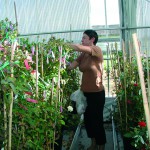The breeding process
The breeding of the Roses Forever mini roses starts with Rosa Eskelund selecting the mother and father roses from her large genetic bank. These future fathers and mothers is then potted and prepared for cross-pollination.
With a brush Rosa Eskelund then moves pollen from one rose to another, just like a bee in the nature, but the process is well controlled and targeted to the wanted outcome. A small label with the information of the parents is attached, and everything is being noted carefully.
After 4-5 months a rose hip is formed with 1-60 seeds, all genetically different, but siblings. Around 50% abort before getting any seeds. The seed that succeeds is now hanging and nurtured on the plant until they are mature, then they are sown and made ready for germination. Only 15% of the seeds will germinate.
Now the difficult selection begins.
The first selection is to find out which should be tested outdoors in the field and which should be tested indoors in the greenhouses. And of course which ones should be discarded.
The test in the greenhouse takes 3.5 years before a new rose is ready to be marketed. The outdoor test takes about 5-6 years before a new garden rose can be marketed.
The breeding is an on-going process and there are constantly new varieties on their way to be marketed. Rosa has about 50,000 small rose sprouts every year, but only a few will be market.
With her passion for roses, Rosa has created many great successes in both mini roses for indoor use, garden roses and cut roses. And since she has been named Rosa by birth, you cannot find a more well-suited name for this passionate rose breeder.






